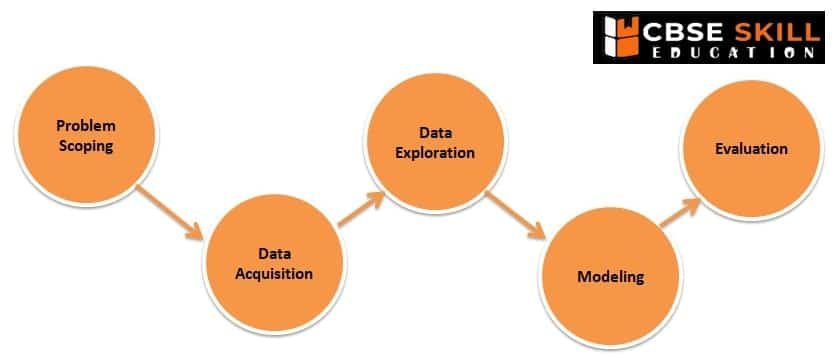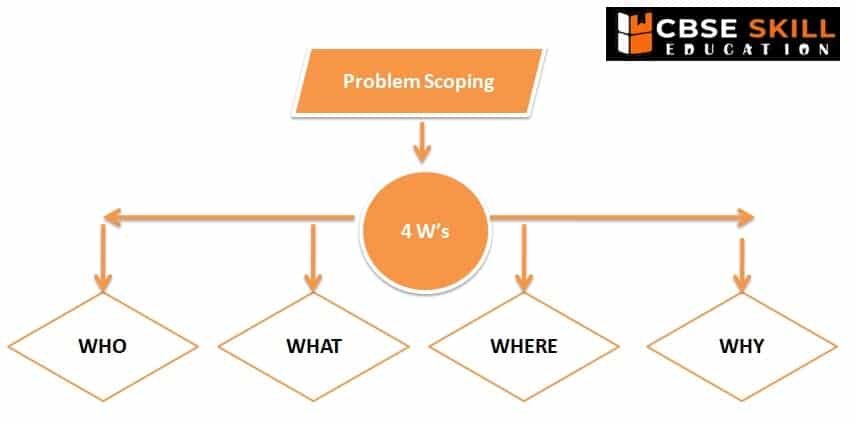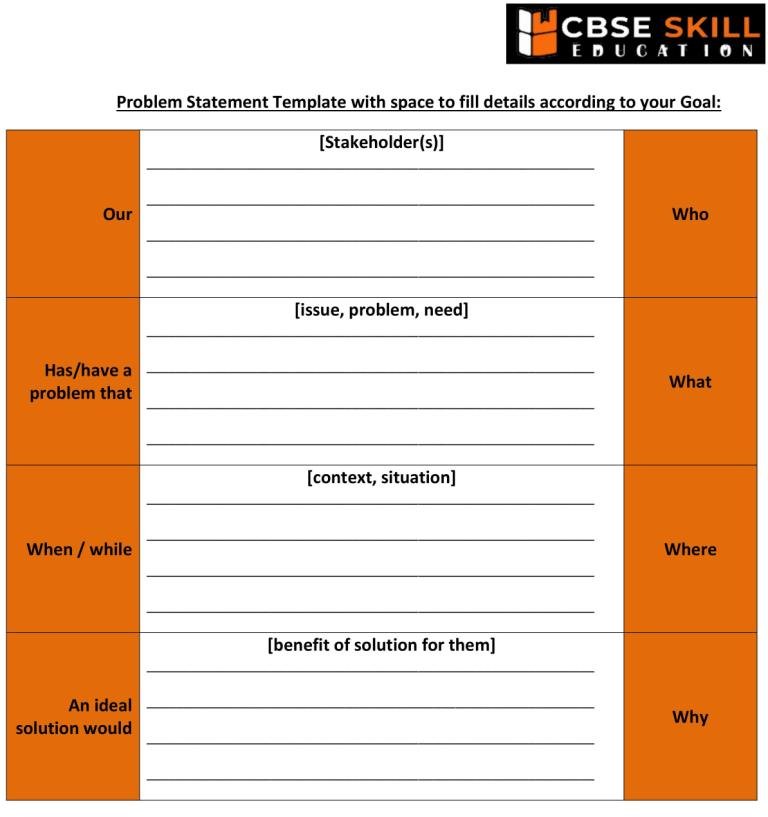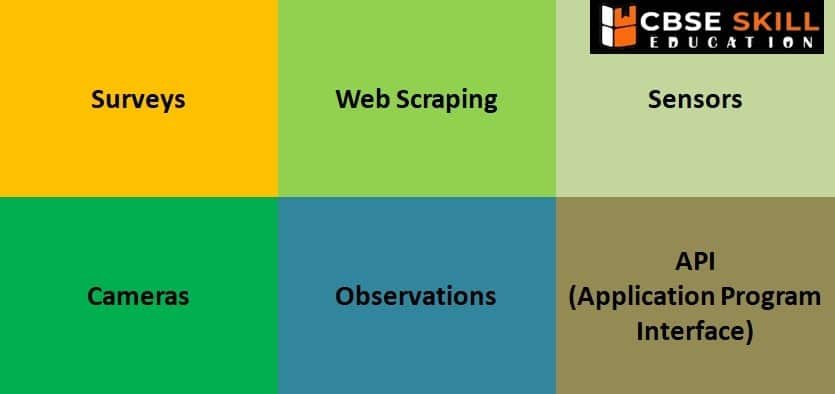Teachers and Examiners (CBSESkillEduction) collaborated to create the AI Project Cycle Class 10 Notes. All the important Information are taken from the NCERT Textbook Artificial Intelligence (417).
AI Project Cycle Class 10

What is AI Project Cycle?
The AI Project Cycle is a step-by-step process that a company must follow in order to solve the problem. The AI Project Cycle offers us a suitable framework that can guide us in the right direction to achieve our goal.
The AI project cycle consists of five main stages –
- Problem Scoping
- Data Acquisition
- Data Exploration
- Modelling
- Evaluation

1. What is Problem Scoping?
It is a fact that we are surrounded by problems. They could be small or big, sometimes ignored or sometimes even critical. Many times, we become so used to a problem that it becomes a part of our life. Identifying such a problem and having a vision to solve it, is what Problem Scoping is about.
Definition – Problem Scoping is a method of AI to analyze the patterns and generate the solutions.
What is 4Ws Problem Canvas?
The 4Ws problem canvas is a framework which helps to solve the problem using four key questions and understand the problem in a better way. The 4Ws Problem Canvas are –
- Who
- What
- Where
- Why

a. Who – The “Who” element helps us to understand the people who is directly and indirectly affected by the problem, and who are known as Stakeholders (Stakeholders are the people who face the problem). Some of the questions which comes under this element.
- Who is inquiring about the product?
- Using Chatbot or email, Who wants to contact Customer Care?
b. What – The “What” elements helps us to analyzing and recognizing the nature of the problem and also collect evidence from the Stakeholders to identify that the problem actually exists or not.
- Inaccurate information from the user
- Users are not responding
- Repetitive inquiries from the users
c. Where – The “Where” element helps to identify the situation where actually stakeholders are facing the problem.
- Where exactly problem started?
- Where exactly do you work?
d. Why – Refers to why we need to address the problem and what the advantages will be for the stakeholders once the problem is solved.
- To increase the sales conversion rates
- To reduce the cost related to customer support.
What is problem statement template?
A problem statement template is a tool which helps to identify the problem. It gives a clear idea of the problem and it helps the organization, how to solve the problem or achieve the Goal. Example of problem statement template –
Problem Statement Template with space to fill details according to your Goal:

2. What is Data Acquisition?
The method of collecting accurate and trustworthy data to work is referred to as data acquisition. Data can be acquired from a variety of sources, including websites, journals, newspapers, and other media, such as text, video, photographs, and audio.
One of the most trustworthy sources for data acquisition are open source website hosted by the government.
There can be various ways in which you can collect data. Some of them are:

3. What is Data Exploration?
Data collection is a complicated thing; it is full of numbers and in order to make sense of it, we need to find the hidden patterns. Here the data exploration comes in, data exploration helps the user to identify the hidden problems and helps the user to take decision.
For Example, if you go to the library and choose a random book, you try to rapidly go through its content by turning pages and reading the description before you decide to borrow it for yourself. This helps you determine whether or not the book is suitable for your requirements and interests this is data exploration.
To analyze the data, you need to visualize it in some user-friendly format so that you can:
- Quickly get a sense of the trends, relationships and patterns contained within the data.
- Define strategy for which model to use at a later stage.
- Communicate the same to others effectively. To visualize data, we can use various types of visual representations.
4. What is Data Modelling?
An AI model is a program that has been trained to recognize patterns using a set of data. AI modeling is the process of creating algorithms, also known as models, that may be educated to produce intelligent results. This is the process of programming code to create a machine artificially.
Generally, AI models can be classified as follows:

Learning Based Approach
AI modelling in which the computer learns on its own. The AI model is trained on the data provided to it under the Learning Based technique, and after that, it is able to create a model that is flexible to the change in data.
The learning-based approach can further be divided into three parts:
1. Supervised Learning
2. Unsupervised Learning
3. Reinforcement Learning
Supervised Learning – In a supervised learning model, the dataset which is fed to the machine is labelled. In other words, we can say that the dataset is known to the person who is training the machine only then he/she is able to label the data.
Unsupervised Learning – Such models work on continuous data. For example, if you wish to predict your next salary, then you would put in the data of your previous salary, any increments, etc., and would train the model. Here, the data which has been fed to the machine is continuous.
Unsupervised Learning – An unsupervised learning model works on unlabeled dataset. This means that the data which is fed to the machine is random and there is a possibility that the person who is training the model does not have any information regarding it.
Unsupervised learning models can be further divided into two categories:
- Clustering – Refers to the unsupervised learning algorithm which can cluster the unknown data according to the patterns or trends identified out of it. The patterns observed might be the ones which are known to the developer or it might even come up with some unique patterns out of it.
- Dimensionality Reduction – We humans are able to visualize upto 3-Dimensions only but according to a lot of theories and algorithms, there are various entities which exist beyond 3-Dimensions. For example, in Natural language Processing
Rule Based Approach
AI modelling in which the developer sets the rules. The machine executes its duty in accordance with the rules or instructions specified by the developer.
5. What is Evaluation?
Once a model has been created and trained, it must undergo appropriate testing in order to determine the model’s effectiveness and performance. Thus, the model is evaluated using Testing Data (which was taken from the dataset generated at the Data Acquisition stage), and the effectiveness of the model is determined using the parameters listed below –

Neural Networks
Neural networks are based in part on how neurons function in the human brain. The main benefit of neural networks is their ability to automatically extract data features without the assistance of a programmer.
Employability skills Class 10 Notes
- Unit 1- Communication Skills Class 10 Notes
- Unit 2- Self-Management Skills Class 10 Notes
- Unit 3- Basic ICT Skills Class 10 Notes
- Unit 4- Entrepreneurial Skills Class 10 Notes
- Unit 5- Green Skills Class 10 Notes
Employability skills Class 10 MCQ
- Unit 1- Communication Skills Class 10 MCQ
- Unit 2- Self-Management Skills Class 10 MCQ
- Unit 3- Basic ICT Skills Class 10 MCQ
- Unit 4- Entrepreneurial Skills Class 10 MCQ
- Unit 5- Green Skills Class 10 MCQ
Employability skills Class 10 Questions and Answers
- Unit 1- Communication Skills Class 10 Questions and Answers
- Unit 2- Self-Management Skills Class 10 Questions and Answers
- Unit 3- Basic ICT Skills Class 10 Questions and Answers
- Unit 4- Entrepreneurial Skills Class 10 Questions and Answers
- Unit 5- Green Skills Class 10 Questions and Answers
Artificial Intelligence Class 10 Notes
- Unit 1 – Introduction to Artificial Intelligence Class 10 Notes
- Unit 2 – AI Project Cycle Class 10 Notes
- Unit 3 – Natural Language Processing Class 10 Notes
- Unit 4 – Evaluation Class 10 Notes
- Advanced Python Class 10 Notes
- Computer Vision Class 10 Notes
Artificial Intelligence Class 10 MCQ
- Unit 1 – Introduction to Artificial Intelligence Class 10 MCQ
- Unit 2 – AI Project Cycle Class 10 MCQ
- Unit 3 – Natural Language Processing Class 10 MCQ
- Unit 4 – Evaluation Class 10 MCQ

I was not happy because there is not much about the subject AI which is fustrating and the cost of the book is not feasible my school told us that no need to buy the book Happy as you are providing notes which is from the book only but just the important things I LOVE IT
ˈ
Thank you🙏 so much cbse for providing us with AI NOTES 📝
Thankyou so much for providing these notes/.